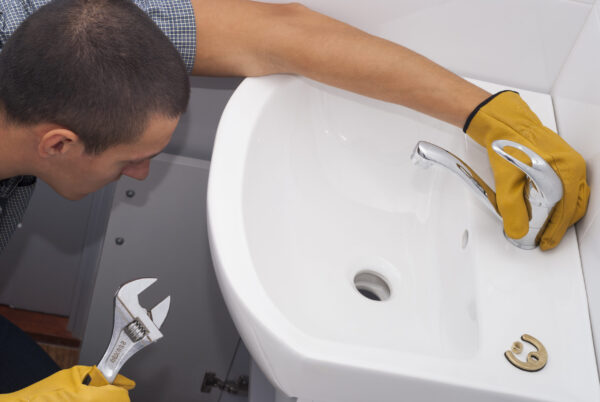Plumbing Parts of a Sink: What You Need to Know

Sinks are a vital part of any kitchen or bathroom, and plumbing parts are essential for them to function properly. Each part of a sink’s plumbing system is necessary for water to be brought in and drained away or to operate faucets. Here’s a look at the most common plumbing parts of a sink.
Trap
The trap is a curved length of pipe that’s placed beneath the sink, and it serves two important functions. First, it prevents sewer gases from entering the home. Second, it traps a small amount of water in the curved base of the pipe, creating a seal that prevents moisture from traveling back up the drainpipe. Without a trap, air could move freely through the pipe, creating an unpleasant odor in your home.
When installing a trap beneath your sink, you have several options. You can buy a pre-shaped trap with its ends already connected or purchase the components separately and assemble them yourself. The latter may give you more flexibility, allowing you to customize the trap’s shape and size to fit your needs. Regardless of which type you choose, it’s important to work with a professional to ensure the trap is properly installed.
To keep your trap functioning optimally, cleaning it out regularly is important. This is especially true if you use it to dispose of food waste as grease and other residue can build up in the trap and cause clogs.
Gasket
In addition to the trap, a gasket is another essential component of your sink’s plumbing system. The gasket seals the connection between your sink and the drain waste system. It prevents water from leaking through the joint and helps keep odors from escaping. Depending on your setup, the gasket may be made from rubber, silicone, or metal.
To ensure a tight seal, use silicone caulk to cover the joint between the sink and the gasket. Without a properly installed gasket, you may experience leaking or even drainage problems. A professional plumber should tighten all the connections with plumber’s tape or putty to prevent leaking.
Jamb Nut
The jamb nut is an important component of your sink’s plumbing system. It holds the faucet in place and provides a secure connection. The jamb nut is a specialized locknut used to fasten objects together. It is a large, flat nut usually made of brass though plastic and stainless steel versions are also available. Its large size allows it to fit snugly against the sink’s surface, providing a secure fit.
For installation, the jamb nut is threaded onto the sink where the faucet will be attached. Once the faucet is in place, it is tightened until it is secure. If the jamb nut is improperly installed, it can cause leaks and other plumbing problems.
Coupling Nut
The coupling nut is a small metal fitting used to attach two pieces of pipe. It’s often used in sink installations, providing a tight seal that prevents the pipes from separating. The coupling nut is made of brass, copper, or stainless steel and comes in various sizes, depending on the type of pipe used. It’s easy to install and is generally very durable, making it a popular choice for plumbing applications. The coupling nut is often used with other fittings, including the slip joint nut, to ensure a secure connection between two pieces of pipe.
A coupling nut can provide an effective seal for years with the right fittings and installation technique. Once installed, the coupling nut should be checked periodically to ensure it’s still in good condition and performing optimally. With proper maintenance, a coupling nut can provide a reliable and long-lasting connection between the two pipes.
Tailpiece
The tailpiece is a short pipe used to connect the sink drain and trap to the main waste line. It’s usually made of ABS or PVC and is easy to install. It should be securely connected with a slip joint nut and washer, ensuring it won’t get loose over time.
When installing a tailpiece, it’s important to ensure the connection is watertight, or else you may have to deal with leaks in the future. Plumber’s tape should be wrapped around the joint to help create a tighter seal and prevent any water from escaping.
Sink plumbing can seem daunting, but it’s quite simple with the right tools and knowledge. Understanding how the different components of your sink’s plumbing system work together is the key to successful installation and maintenance. Working with a professional plumbing company like Mullen Plumbing, Heating and Cooling is the best way to ensure your sink is installed correctly and will remain in good working order for years.
With our expertise, you can rest assured that your sink plumbing is in good hands. We can also help with water heater installations and repair, toilet repair and replacement, AC and maintenance, and heater installation and repair in the Kanahwa Valley. Contact Mullen Plumbing, Heating and Cooling today to learn more about our services and how we can help with all your plumbing needs!
